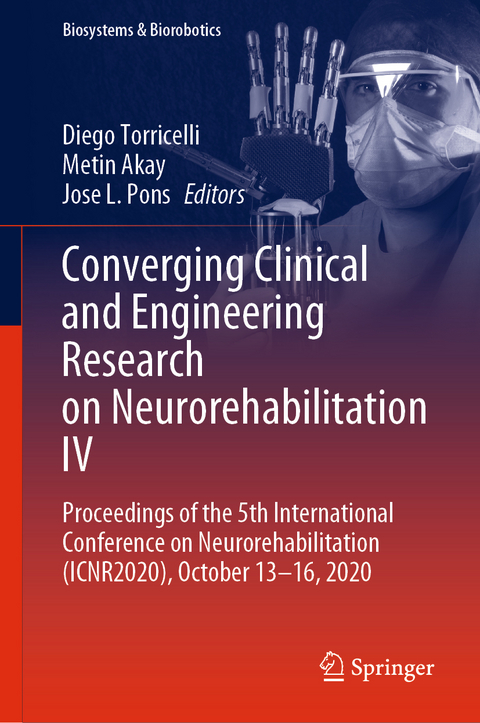
Converging Clinical and Engineering Research on Neurorehabilitation IV
Proceedings of the 5th International Conference on Neurorehabilitation (ICNR2020), October 13–16, 2020
Seiten
2021
|
1st ed. 2022
Springer International Publishing (Verlag)
978-3-030-70315-8 (ISBN)
Springer International Publishing (Verlag)
978-3-030-70315-8 (ISBN)
The book reports on advanced topics in the areas of neurorehabilitation research and practice. It focuses on new methods for interfacing the human nervous system with electronic and mechatronic systems to restore or compensate impaired neural functions. Importantly, the book merges different perspectives, such as the clinical, neurophysiological, and bioengineering ones, to promote, feed and encourage collaborations between clinicians, neuroscientists and engineers. Based on the 2020 International Conference on Neurorehabilitation (ICNR 2020) held online on October 13-16, 2020, this book covers various aspects of neurorehabilitation research and practice, including new insights into biomechanics, brain physiology, neuroplasticity, and brain damages and diseases, as well as innovative methods and technologies for studying and/or recovering brain function, from data mining to interface technologies and neuroprosthetics. In this way, it offers a concise, yet comprehensive referenceguide to neurosurgeons, rehabilitation physicians, neurologists, and bioengineers. Moreover, by highlighting current challenges in understanding brain diseases as well as in the available technologies and their implementation, the book is also expected to foster new collaborations between the different groups, thus stimulating new ideas and research directions.
How to challenge patients during gait training: The effect of immersive virtual reality on the gait pattern in people post-stroke.- Automatic versus Manual Tuning of Robot-Assisted Gait Training.- Six weeks use of a wearable soft-robotic glove during ADL: preliminary results of ongoing clinical study.- Proof-of-concept of POF-based pressure sensors embedded in a smart garment for impact detection in perturbation assessment.-Influence of innovative rehabilitation technology on intensity of training: preliminary results.- Challenges in adaptive robot-assisted gait training: the balancing act of minimizing assistance while preserving safety.
| Erscheinungsdatum | 16.10.2021 |
|---|---|
| Reihe/Serie | Biosystems & Biorobotics |
| Zusatzinfo | XXI, 975 p. 299 illus., 273 illus. in color. |
| Verlagsort | Cham |
| Sprache | englisch |
| Maße | 155 x 235 mm |
| Gewicht | 1658 g |
| Themenwelt | Medizin / Pharmazie ► Physiotherapie / Ergotherapie ► Orthopädie |
| Technik | |
| Schlagworte | Artificial Sensory Feedback • Exoskeleton Control Systems • Gait Rehabilitation Robotics • Human - Machine Interfaces for Rehabilitation • Lower/Upper Limb Rehabilitation • motion capture systems • Motor Control Task • Muscle Synergies In Rehabilitation • Neurofeedback Training in Rehabilitation • Personalized Musculoskeletal Modeling • Post-stroke Rehabilitation • Proceedings of ICNR2020 • Rehabilitation Gaming System • Robot-Assisted Rehabilitation • Soft Exoskeletons for Rehabilitation • Virtual Reality-Based Rehabilitation |
| ISBN-10 | 3-030-70315-0 / 3030703150 |
| ISBN-13 | 978-3-030-70315-8 / 9783030703158 |
| Zustand | Neuware |
| Haben Sie eine Frage zum Produkt? |
Mehr entdecken
aus dem Bereich
aus dem Bereich
Spiraldynamik - programmierte Therapie für konkrete Resultate
Buch | Hardcover (2021)
Thieme (Verlag)
CHF 146,95


